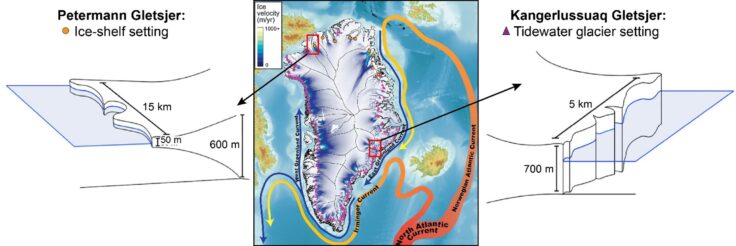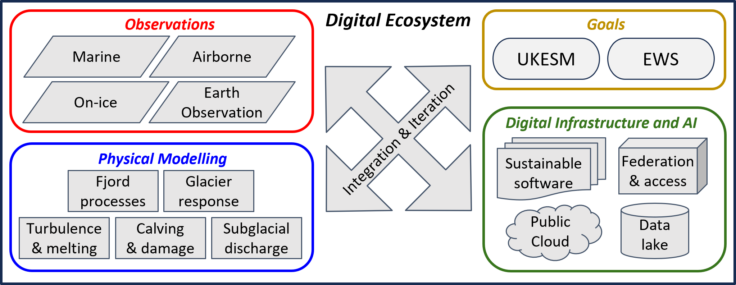GRAIL
GReenland ice sheet to Atlantic tipping points from Ice-sheet Loss
- Start date
- 1 April, 2025
- End date
- 31 March, 2030
GRAIL aims to quantify the key link between the North Atlantic ocean and the Greenland Ice Sheet: melting and calving at Greenland’s glaciers. The physical processes controlling melting and calving are chronically under-studied due to the difficulty in accessing ice-choked fjords. We will monitor these processes using new ocean/ice/airborne platforms in both East and North-West Greenland, and then build these new observations into physical models of melting and calving. The new process understanding will be built into the UK Earth System Model, and feed into a prototype Early Warning System.
Supported by the ARIA Forecasting Tipping Points progamme, GRAIL brings together a wide range of expertise from a large international team:
- British Antarctic Survey
- Cambridge University
- Cornell University
- Danish Meteorological Institute
- Edinburgh University
- Leeds University
- National Oceanography Centre
- Oregon State University
- Reading University
- Scottish Association for Marine Science
- St. Andrews University
- Stirling University
- Technical University of Denmark
- The Alan Turing Institute
All BAS staff involved in the project are listed in the ‘People’ tab above.
Summary
The stability of the Atlantic Ocean circulation under increasing greenhouse gases is of critical concern due to its potential to create large, abrupt changes in European and global climate. Central to this discussion is the question of whether open-ocean convection in the North Atlantic Subpolar Gyre can be sustained under a future freshening of the sea surface. Future changes in freshwater forcing of the North Atlantic could come from rivers, sea ice, precipitation, or ice loss from the Greenland Ice Sheet. The Greenland freshwater source is growing, highly uncertain, and holds the potential for abrupt future change.
Greenland ice loss is occurring through increased surface melting and glacier discharge. Surface melting processes are relatively well understood, and are incorporated into climate models. Changes in ice discharge, on the other hand, are far less well constrained. They are triggered at the glacier terminus through changes in melting and iceberg calving in the >200 deep, narrow fjords surrounding Greenland. Melting is controlled by changes in fjord ocean conditions and by the injection of subglacial meltwater from beneath the glaciers. Calving and fjord conditions are modulated by melting, the presence of iceberg mélange, and fjord geometry. However, the physics of fjord melting and calving are completely absent from climate models.
Project Aims
GRAIL will advance our understanding of melting and calving processes by launching new ocean/ice/airborne platforms and advancing robotic exploration, physical modelling and Artificial Intelligence approaches. We will build melting and calving physics into the UK Earth System Model to enable prediction of the global impacts of Greenland ice loss, and we will deliver a prototype Early Warning System (EWS) built on physical parameterisations and statistical emulators. Our project aims are illustrated below.



Kelly Hogan
Marine Geophysicist
BAS-Arctic Working Group, Palaeo Environments, Ice Sheets and Climate Change team
James Byrne
Principal Software Engineer
Digital Innovation Team, Artificial Intelligence (AI) Lab, BAS IT team